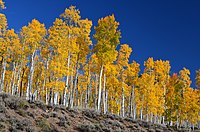
Photo from wikipedia
From 2012 to 2015, several field surveys were conducted throughout forest areas in the north of Iran in order to determine the occurrence of species of Botryosphaeriaceae on forest trees.… Click to show full abstract
From 2012 to 2015, several field surveys were conducted throughout forest areas in the north of Iran in order to determine the occurrence of species of Botryosphaeriaceae on forest trees. Fungal isolations were made from symptomatic branches of 20 tree genera including Acer, Alnus, Carpinus, Crataegus, Cupressus, Cydonia, Diospyros, Fagus, Fraxinus, Gleditsia, Mespilus, Parrotia, Pinus, Populus, Prunus, Pterocarya, Punica, Quercus, Ulmus and Zelkova, as well as fruiting bodies formed on the surface of woody debris. Morphological identification along with molecular analysis of the internal transcribed spacer region (ITS1-5.8S-ITS2) of the nuclear ribosomal DNA (rDNA) and a partial sequence of translation elongation factor 1-α (tef-1α) gene showed that at least nine species of Botryosphaeriaceae occur on forest trees in the north of Iran. These include Dothiorella sarmentorum, Dothiorella plurivora, Neofusicoccum parvum, Botryosphaeria dothidea, Neoscytalidium novaehollandiae, Diplodia seriata, Diplodia sapinea, Lasiodiplodia mahajangana and Diplodia intermedia. Pathogenicity tests were conducted for selected isolates from each species on six tree species (Mespilus germanica, Punica granatum, Parrotia persica, Alnus glutinosa, Quercus castaneifolia and Pterocarya fraxinifolia) under field conditions. Results of the pathogenicity tests showed a variation in lesion lengths (virulence) and re-isolation frequencies of inoculated species on branches of trees, Neoscytalidium novaehollandiae, B. dothidea and D. intermedia being the most virulence species. Based on host plant species, the majority of Botryosphaeriaceae species are new records. This is the first comprehensive study on the species identification, distribution and pathogenicity of Botryosphaeriaceae on forest trees in Iran. This is also the first report of L. mahajangana in this country.
Journal Title: European Journal of Forest Research
Year Published: 2019
Link to full text (if available)
Share on Social Media: Sign Up to like & get
recommendations!